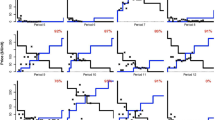Abstract
In order to improve prices at Amazon, we created Pricing Labs, a price experimentation platform. Since we do not price discriminate, we must run product-randomized experiments. We discuss how we randomize to prevent spillovers, run different experimental designs (i.e., crossovers) to improve precision, and control for demand trends and differences in treatment groups to get more precise treatment effect estimates.





Similar content being viewed by others
References
Aronow, Peter M., Dean Eckles, Cyrus Samii, and Stephanie Zonszein. 2021. Spillover Effects in Experimental Data. In Advances in Experimental Political Science )J. Druckman and D. Green, editors). Cambridge: Cambridge University Press.
Athey, Susan., Peter J. Bickel, Alloy Chen, Guido W. Imbens, and Michael Pollmann. 2021. Semiparametric Estimation of Treatment Effects in Randomized Experiments. National Bureau of Economic Research Working Paper no. 29242.
Deng, Alex, Ya Xu, Ron Kohavi, and Toby Walker. 2013. Improving the sensitivity of online controlled experiments by utilizing pre experiment data. Proceedings of the sixth ACM international conference on Web search and data mining.
Vehtari, Aki., Daniel Simpson, Andrew Gelman, Yuling Yao, and Jonah Gabry. 2015. Pareto smoothed importance sampling. http://arxiv.org/abs/1507.02646.
Wager, Stefan, and Susan Athey. 2018. Estimation and Inference of Heterogeneous Treatment Effects Using Random Forests. Journal of the American Statistical Association 113 (523): 1228–1242.
Funding
Funding was provided by Amazon.
Author information
Authors and Affiliations
Corresponding author
Additional information
Publisher's Note
Springer Nature remains neutral with regard to jurisdictional claims in published maps and institutional affiliations.
Appendix: Power analysis with cluster randomization
Appendix: Power analysis with cluster randomization
There are two different approaches in estimating the power that we study here: (1) an analytical closed-form expression considering a normality assumption, or (2) simulation-based power analysis. The closed-form expression is more computationally efficient while its assumptions are more difficult to justify. In particular, the closed-form expression is not valid for our constrained randomization and causal forest treatment effect estimation.
We next perform power calculations mentioned above using the experiment data. In randomizing the clusters, we balanced across the treatment and control groups on different financial metrics and the cluster size following the process described in Sect. 4.1.3. We consider a 6%, 8%, and 10% effect sizes (since this experiment was not well-powered, we selected larger effect sizes). Table 4 summarizes the power results.
Rights and permissions
Springer Nature or its licensor (e.g. a society or other partner) holds exclusive rights to this article under a publishing agreement with the author(s) or other rightsholder(s); author self-archiving of the accepted manuscript version of this article is solely governed by the terms of such publishing agreement and applicable law.
About this article
Cite this article
Cooprider, J., Nassiri, S. Science of price experimentation at Amazon. Bus Econ 58, 34–41 (2023). https://doi.org/10.1057/s11369-023-00303-9
Published:
Issue Date:
DOI: https://doi.org/10.1057/s11369-023-00303-9




